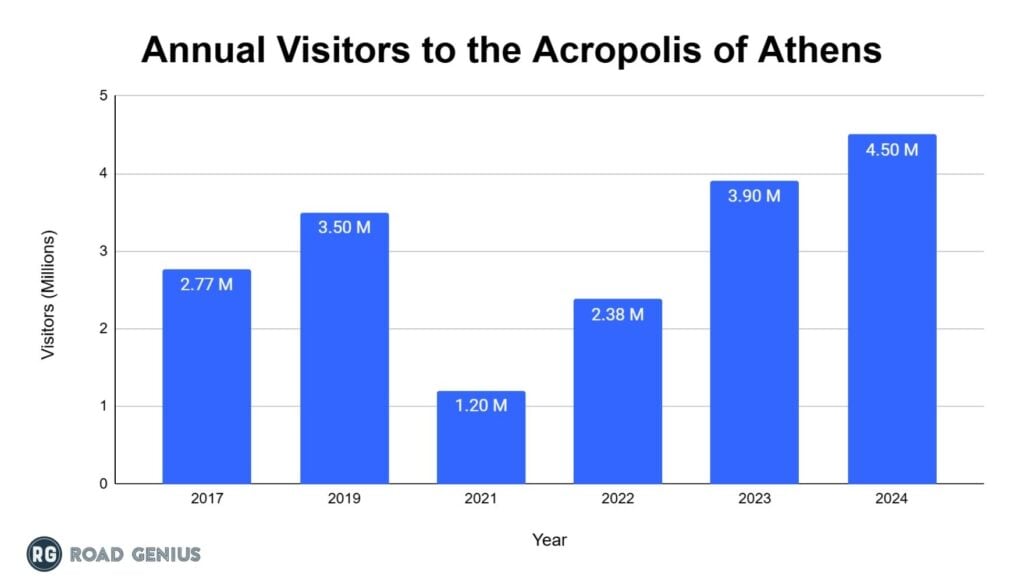Page last updated: 20 July 2025
The Parthenon, dedicated to Athena, is the Acropolis’s most renowned structure, crafted entirely from white marble. With its harmonious proportions, gentle curves, and intricate sculptures, it stands as a masterpiece of ancient Greek architecture.
How many people visit the Parthenon every year?
Over 4.5 million people visited the Acropolis of Athens, home to the Parthenon and other ancient Greek monuments, in 2024.
- In 2022, the Acropolis welcomed 2.38 million visitors. The number of tourists increased by 80% during June and July compared to the same period in 2019.1
- The Acropolis welcomed 1.2 million visitors in 2021 during the coronavirus pandemic and 3.5 million visitors in 2019 before the coronavirus pandemic

How many tourists visited the Parthenon in 2024?
- In 2024, the Acropolis, home to the Parthenon, welcomed over 4.5 million visitors, representing a 15.4% rise from 2023 and a 28.6% gain compared to 2019.
How much do visitors spend visiting the Parthenon every year?
- In 2024, the Acropolis of Athens, where the Parthenon is located, generated €128.0 million in aggregate receipts, a 4.7% increase from €122.3 million in 2023. 2

How much does it cost to visit the Parthenon?
The Parthenon is an archaeological site located at the top hill of the Acropolis of Athens. Here are the ticket costs:
- €24.50: Acropolis and Parthenon tickets with an optional audio guide.
- €36: Combo – Acropolis plus 6 archaeological sites multipass ticket.
- €45: Acropolis guided tour with entry tickets.
- €44.50: Acropolis Parthenon plus Acropolis Museum tickets.
Impact of Coronavirus – Parthenon at the Acropolis of Athens Statistics 2021
- The Acropolis of Athens, like many tourist destinations around the world, was significantly affected by the coronavirus pandemic. Due to travel restrictions, lockdown measures, and health concerns, the number of tourists visiting the Acropolis of Athens declined.
- Tourist visitation dropped to 34% or 1.2 million visitors in 2021 compared to 3.5 million visitors in 2019 before the coronavirus pandemic.
How popular is the Parthenon as a tourist destination?
- Classified as a UNESCO World Heritage Site, the Acropolis of Athens, including the Parthenon, is one of the greatest achievements of European culture and the most important monument in Greece.3
Greece Travel Resources
When is the best time to visit the Parthenon at the Acropolis of Athens?
- The best months to visit the Parthenon are from April to mid-June or from mid-September onwards. During these periods, visitors can enjoy pleasant weather conditions and quieter streets with fewer tourists.
Why do people visit Parthenon?
People visit the Parthenon primarily to experience its historical and cultural significance as an enduring symbol of ancient Greek democracy and artistic achievement.
- Visitors admire its architectural mastery, including its Doric columns, optical refinements, and intricate marble sculptures.
- Enjoy panoramic views of Athens from a UNESCO World Heritage Site.
Parthenon History
When was the Parthenon built?
- The Parthenon was constructed during the height of the Athenian Empire in the mid-5th century BCE. The construction began in 447 BCE and was completed in 438 BCE, although decorative work continued until 432 BCE.
What was the Parthenon used for?
In the modern era, the Parthenon stands as a symbol of ancient Greece’s cultural heritage and architectural mastery.
- Originally constructed as a temple dedicated to Athena Parthenos, the Parthenon symbolised Athenian power and religious devotion after their victory over the wars.
- Beyond its religious purpose, the Parthenon functioned as the treasury for the Delian League, a coalition of Greek city-states under Athens’ leadership.
Over centuries, the Parthenon underwent various transformations:
- Byzantine Church: Converted to a Christian church dedicated to the Virgin Mary after the decline of paganism.
- Catholic Cathedral: Served as a Roman Catholic cathedral during the Latin occupation in the 13th century.
- Mosque: Transformed into a mosque under Ottoman rule in the 15th century.
- Ammunition Storage: Used as ammunition storage by the Ottomans in 1687, resulting in significant damage from Venetian artillery.
Following Greece’s independence in the 19th century, the Parthenon became a symbol of national pride and a prominent tourist site.
Europe Travel Statistics Resources
- Austria Statistics
- Belgium Statistics
- Croatia Statistics
- Denmark Statistics
- France Statistics (incl. Paris, Disneyland Paris, Eiffel Tower, Louvre Museum, Notre Dame)
- Georgia Statistics
- Germany Statistics (incl. Berlin)
- Greece Statistics (incl. Parthenon)
- Iceland Statistics
- Italy Statistics (incl. Florence, Milan, Rome, Venice)
- Netherlands Statistics (incl. Amsterdam)
- Norway Statistics
- Portugal Statistics (incl. Lisbon)
- Spain Statistics (incl. Barcelona, Madrid, Mallorca)
- Sweden Statistics
- Switzerland Statistics
- UK Statistics (incl. Edinburgh, Glasgow, London, Oxford, Scotland)
References
- NewArtnet: Tourism to Acropolis ↩︎
- TheNationalNews: Renovation at Acropolis of Athens ↩︎
- Greeka: UNESCO Sites list of Greece & the islands – Acropolis of Athens ↩︎
